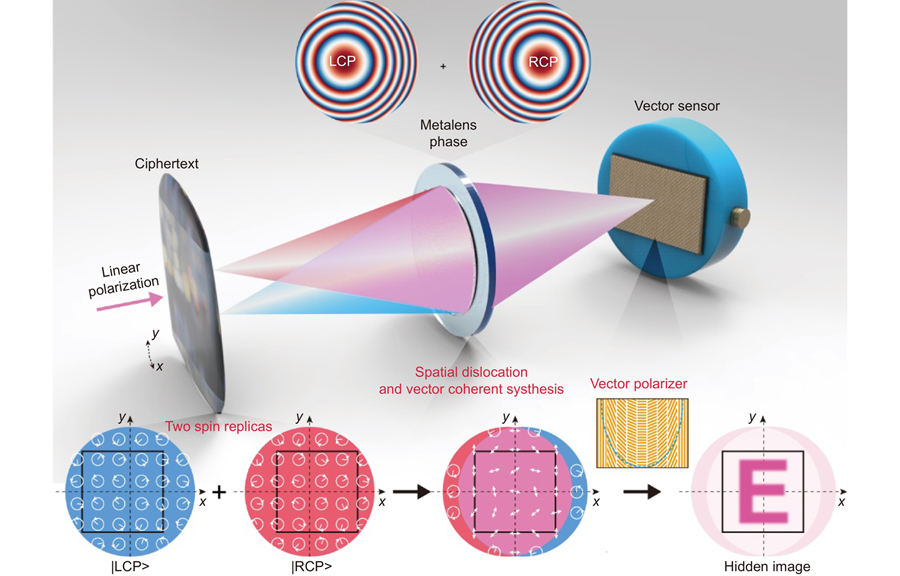Abstract
Meta optics-empowered vector visual cryptography at the abundant degrees of freedom of light and spatial dislocation can open an avenue for optical information security and anti-counterfeiting with a compact footprint and rapid decryption.In a recent paper published in Nature Communications11, Xiangang Luo and his team at Institute of Optics and Electronics, Chinese Academy of Sciences propose a new encryption and decryption method based on the vector optical imaging of a single meta-device, called vector visual cryptography, to solve the bottleneck problem in this realm, i.e., high security and rapid decryption speed can hardly be achieved simultaneously in an all-optical manner. The key physics behind is the custom-defined vectorial synthesis between the opposite spin components enabled by spin-decoupled metasurfaces, including the spin-division of a complex-amplitude optical ciphertext, single-to-dual or dual-to-single mapping, and complex interference with spatial dislocation. Consequently, the complex encryption process can be reversely decrypted via a compact meta-camera with an instantaneous measurement.

Figure 1.Schematics of a meta-optics-empowered decryption camera for vector visual cryptography11.
Figure 1 demonstrates the concept of the meta-camera, including two elements. Pixel-wise spatial dislocation and overlap are generated between the two spin replicas of a ciphertext image via spin-decoupled dual-axis metalens. A vector sensor is used, including a vector polarization analyzer attached to a photodetector. The imaging mechanism of the decryption camera is equivalent to the reversal process of the coding procedure. The metalens separates any pixel to the vector coherent synthesis of RCP and LCP components at the overlapping region on the image plane under the illumination of linearly polarized light. Furthermore, the vector visual cryptography is demonstrated at the wavelength of 10.6 μm to prove the proposed concept. All-silicon nanopillars are arranged in a square lattice with the period and height being kept as meta-atoms, which are fabricated by direct laser writing. Optical ciphertexts with binary pure-amplitude, binary pure-phase, and grayscale complex-amplitude encryption are fabricated and also characterized. Optical ciphertext with arbitrary complex-amplitude distributions is also decrypted directly by the decryption meta-camera with proper design and a set of matched key parameters. Security of the vector visual cryptography is verified under different physical parameters. The decryption is failed when missing any of secret keys. Confidential information can only be retrieved with relatively high image fidelity in a small area. The hidden image can be reconstructed precisely at the center of the hot spots.
As the world increasingly goes digital, any part of the application that deals with e-commerce, banking, or finance requires the heaviest data security and encryption. Information security is of utmost importance in various applications, including anti-counterfeiting and communications. In the past decades, optical cryptography techniques have gained considerable attention due to their advantages of low-power consumption, high-speed parallel processing, and multi-dimensional capabilities1, 2 compared to their electrical counterparts. The new technology appearance of the optical cryptography, including optical watermarking3, steganography4, and visual cryptography5, 6 open up a gate for securing information. Current optical encryption strategies are difficult to be popularized, suffering from bulky system volume, relatively low-security level, redundant measurement, and/or requirement of digital decryption algorithms. The vast majority of meta-optics-based cryptography techniques can be potentially cracked by adjusting the polarization state of input and output light or illumination wavelength, leading to a limited security level7. Conventional approaches to enhance the security level are combining holographic cryptography with computational imaging8, significantly impeding the decryption speed and measurement convenience. The main bottleneck in this realm is to achieve high security and rapid decryption speed simultaneously. The spatially varied polarization property of vector light9, 10 is not fully exploited in optical cryptography. Therefore, it is crucial to develop new techniques that can fully exploit the degrees of freedom in light for optical cryptography without resorting to indirect imaging methods. Such techniques would enhance the security of optical cryptography while retaining the benefits of parallel processing, high-speed, and low-power consumption properties.
The proposed vector visual cryptography is expected to find applications in optical information security and anti-counterfeiting with the advantages of a compact footprint, high-security level, and rapid decryption. It enhances a high-security level due to the abundance of key parameters, including wavelength, phase, amplitude, polarization, and spatial dislocation. These parameters make it difficult to decrypt the system by try-and-error attacks, significantly upgrading the security level compared to scalar visual cryptography and polarization multiplexed holography12. In addition, such an approach improves the decryption speed and measurement convenience significantly, which are of significance in the future development of optical security13. Its potential for all-optical image processing and intelligent recognition makes it a compelling solution that can be integrated into compact systems while maintaining high-security levels and real-time decryption.
References
[4] Cao Y, Tang LL, Li JQ, Lee C, Dong ZG. Multiplexing optical images for steganography by single metasurfaces. Small, 2206319 (2023). https://doi.org/10.1002/smll.202206319
![]()




